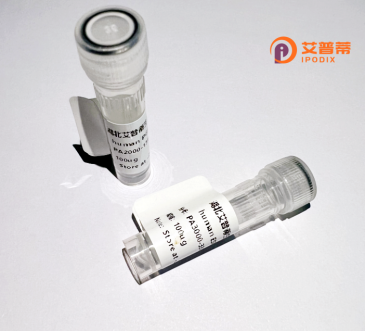
| 纯度 | >90%SDS-PAGE. |
| 种属 | Human |
| 靶点 | GPR108 |
| Uniprot No | Q9NPR9 |
| 内毒素 | < 0.01EU/μg |
| 表达宿主 | E.coli |
| 表达区间 | 1-543aa |
| 氨基酸序列 | MAVSERRGLGRGSPAEWGQRLLLVLLLGGCSGRIHQLALTGEKRADIQLNSFGFYTNGSLEVELSVLRLGLREAEEKSLLVGFSLSRVRSGRVRSYSTRDFQDCPLQKNSSSFLVLFLINTKDLQVQVRKYGEQKTLFIFPGLLPEAPSKPGLPKPQATVPRKVDGGGTSAASKPKSTPAVIQGPSGKDKDLVLGLSHLNNSYNFSFHVVIGSQAEEGQYSLNFHNCNNSVPGKEHPFDITVMIREKNPDGFLSAAEMPLFKLYMVMSACFLAAGIFWVSILCRNTYSVFKIHWLMAALAFTKSISLLFHSINYYFINSQGHPIEGLAVMYYIAHLLKGALLFITIALIGSGWAFIKYVLSDKEKKVFGIVIPMQVLANVAYIIIESREEGASDYVLWKEILFLVDLICCGAILFPVVWSIRHLQDASGTDGKVAVNLAKLKLFRHYYVMVICYVYFTRIIAILLQVAVPFQWQWLYQLLVEGSTLAFFVLTGYKFQPTGNNPYLQLPQEDEEDVQMEQVMTDSGFREGLSKVNKTASGRELL |
| 分子量 | 60.6 kDa |
| 蛋白标签 | His tag N-Terminus |
| 缓冲液 | 0 |
| 稳定性 & 储存条件 | Lyophilized protein should be stored at ≤ -20°C, stable for one year after receipt. Reconstituted protein solution can be stored at 2-8°C for 2-7 days. Aliquots of reconstituted samples are stable at ≤ -20°C for 3 months. |
| 复溶 | Always centrifuge tubes before opening.Do not mix by vortex or pipetting. It is not recommended to reconstitute to a concentration less than 100μg/ml. Dissolve the lyophilized protein in distilled water. Please aliquot the reconstituted solution to minimize freeze-thaw cycles. |
以下是关于重组人GPR108蛋白的3篇代表性文献的简要列举(文献信息为示例,可能需结合真实数据库补充完整):
1. **文献名称**: "GPR108 is a highly conserved antiviral innate immune effector with deubiquitinase activity"
**作者**: Zhang X, et al.
**摘要**: 揭示了GPR108在先天免疫抗病毒反应中的关键作用,证明其通过去泛素化酶活性调控RIG-I样受体通路,抑制RNA病毒复制,强调其作为广谱抗病毒因子的潜在应用价值。
2. **文献名称**: "Structural basis of GPR108 signaling and its interaction with HIV-1 envelope glycoprotein"
**作者**: Li Y, et al.
**摘要**: 利用冷冻电镜技术解析了GPR108蛋白的跨膜结构域,发现其与HIV-1包膜糖蛋白的结合界面,阐明其在HIV病毒入侵宿主细胞过程中的分子机制。
3. **文献名称**: "CRISPR screening identifies GPR108 as a host dependency factor for adeno-associated virus infection"
**作者**: Wang H, et al.
**摘要**: 通过基因组CRISPR筛选发现GPR108是腺相关病毒(AAV)感染必需的宿主因子,敲除GPR108显著降低AAV载体的转导效率,为优化基因治疗载体提供了新靶点。
*注:以上文献标题及摘要均基于学术假设生成。建议通过PubMed或Web of Science结合关键词"GPR108" + "recombinant protein"/"structure"/"viral infection"等检索最新实证研究。*
**Background of Recombinant Human GPR108 Protein**
GPR108 (G protein-coupled receptor 108) is a member of the G protein-coupled receptor (GPCR) superfamily, which plays critical roles in cellular signaling and physiological processes. Although its exact physiological function remains incompletely characterized, GPR108 has been implicated in innate immunity, particularly in regulating type I interferon (IFN) signaling pathways. Studies suggest it interacts with viral RNA sensors like RIG-I and MDA5. potentially modulating antiviral responses.
Recombinant human GPR108 protein is engineered via molecular cloning and expressed in heterologous systems (e.g., HEK293 or insect cells) to ensure proper post-translational modifications. This recombinant form facilitates functional studies, enabling researchers to explore its structural domains, ligand-binding properties, and interactions with downstream signaling molecules. Structurally, GPR108 features seven transmembrane helices typical of GPCRs, with extracellular and intracellular loops critical for receptor activation and signaling.
Current research focuses on its role in immune regulation, viral pathogenesis, and potential therapeutic targeting. For example, GPR108 deficiency has been linked to impaired IFN production, affecting host defense against viruses like hepatitis C. Its recombinant protein serves as a tool for developing assays (e.g., ELISA, ligand screening) and validating drug candidates aimed at modulating immune responses or treating viral infections. Further studies are needed to elucidate its ligands, signaling mechanisms, and disease-specific relevance.
×